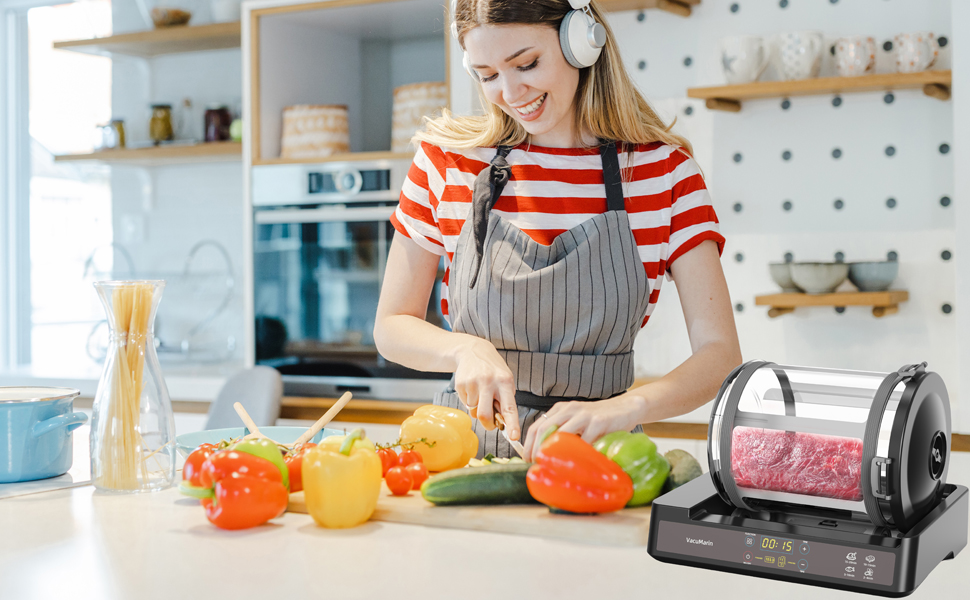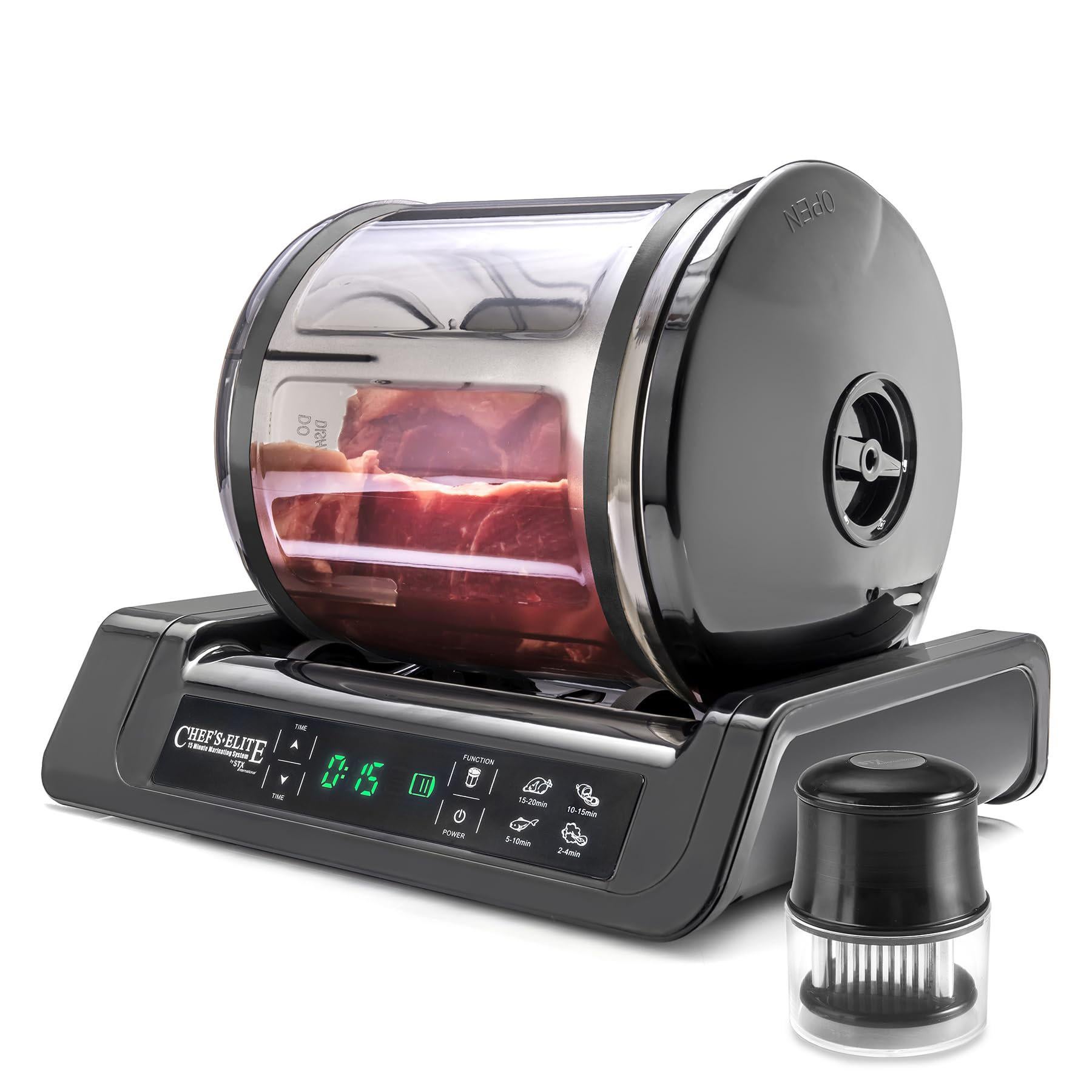10 years of experience as a food machinery equipment manufacturer
10 years of experience as a food machinery equipment manufacturer
The art of marination, a culinary technique cherished for centuries, plays a pivotal role in enhancing the flavor, tenderness, and moisture of various meats. Traditional methods, often involving lengthy soaking periods, have long been the standard. However, the pursuit of efficiency and consistency in both commercial kitchens and home culinary endeavors has spurred innovation. Among these advancements is the vacuum tumbler meat marinator, a device engineered to expedite and optimize the marination process.

A vacuum tumbler meat marinator is a specialized piece of equipment designed to infuse marinades into meat products more effectively and rapidly than conventional techniques. The core principle of its operation involves two primary actions: the creation of a vacuum environment and a gentle tumbling or massaging motion. The unit typically consists of a drum or container where the meat and marinade are placed. A vacuum pump then removes air from this drum, creating a low-pressure environment. Simultaneously, the drum rotates or tumbles, ensuring continuous contact between the meat and the marinade, as well as providing a mechanical massaging action.
This combination of vacuum and tumbling works synergistically. The vacuum causes the muscle fibers of the meat to expand and creates a pressure differential that helps draw the marinade deep into the tissue. The tumbling action not only ensures even distribution of the marinade over all surfaces of the meat but also contributes to tenderization by gently working the muscle fibers.
The adoption of vacuum tumbler meat marinators offers a range of benefits that address common challenges in meat preparation. These advantages are particularly noticeable when compared to static marination methods.
Many models are constructed from food-grade stainless steel, ensuring durability, hygiene, and resistance to corrosion from acidic marinades. Control panels may offer programmable settings for vacuum levels, tumbling duration, and rotation speed, allowing for precise customization of the marination process for different types of meat and recipes.
The operational cycle of a vacuum tumbler meat marinator is a well-orchestrated sequence designed for optimal results. The process typically begins with loading the meat product and the prepared marinade into the tumbler drum. The ratio of meat to marinade is an important factor, often recommended by equipment manufacturers or determined through experimentation.
Once the drum is sealed, the vacuum pump is activated. Air is evacuated from the drum, creating a sub-atmospheric pressure environment. This reduction in pressure has several effects. Firstly, it removes air from within the pores and crevices of the meat itself. Secondly, the lower external pressure causes the meat fibers to expand slightly, creating more space for marinade uptake. This phenomenon is critical, as it effectively “opens up” the meat structure.
With the vacuum established, the tumbling phase begins. The drum rotates, either continuously or intermittently, at a controlled speed. This motion serves multiple purposes. It ensures that all meat surfaces are consistently coated with the marinade. The physical action of the meat pieces falling and rubbing against each other, and against the baffles often present inside the drum, provides a massaging effect. This mechanical action aids in breaking down connective tissues, further enhancing tenderness, and also helps to work the marinade into the meat. The combination of the pressure differential created by the vacuum and the mechanical agitation of tumbling significantly accelerates the diffusion of the marinade into the meat compared to simple soaking.
The duration of the vacuum and tumbling cycle is programmable and depends on factors such as the type and cut of meat, its thickness, and the desired level of marination. Some advanced units may incorporate resting periods within the cycle, allowing the meat to absorb the marinade more fully between tumbling phases.
While primarily known for marinating, the utility of vacuum tumblers extends to several other food preparation processes, making them versatile tools in both commercial and specialized culinary settings.
One significant application is in curing meats. Processes for making products like bacon, ham, or corned beef traditionally involve long curing times. Vacuum tumbling can expedite the penetration of curing solutions (containing salt, nitrates/nitrites, and flavorings) into the meat, reducing overall curing time while ensuring even distribution of the curing agents. This leads to consistent color development and flavor profile in the final cured product.

Similarly, for creating jerky or other dried meat products, a vacuum tumbler can be used to thoroughly infuse the meat strips with a seasoned marinade before the drying process. This ensures that the flavor is locked in and distributed evenly throughout each piece.
Beyond meat, some specialized vacuum tumblers can be adapted for infusing flavors into other food items, though their primary design focuses on meat products. The mechanical action can also be used for simply tenderizing meat without a liquid marinade, through a process known as mechanical massaging, or for evenly distributing dry rubs and seasonings.
The ability to control the process parameters also allows for experimentation, enabling chefs and food processors to develop unique flavor profiles and textures that might be difficult to achieve with traditional methods.
Choosing the right vacuum tumbler meat marinator requires careful consideration of several factors, tailored to the specific needs of the user, whether for a bustling commercial kitchen or a dedicated home enthusiast.
Capacity is a primary concern. Models range from small, countertop units suitable for a few kilograms of meat, ideal for small restaurants or home use, to large industrial machines capable of processing hundreds or even thousands of kilograms per batch. Assessing the volume of meat to be processed regularly is crucial.
The material of construction is vital for durability and food safety. Stainless steel, particularly food-grade types like 304 or 316, is preferred for its resistance to corrosion, ease of cleaning, and ability to withstand the rigors of commercial use. The interior finish of the drum should also be smooth to facilitate easy cleaning and prevent food particle buildup.
The quality and power of the vacuum pump directly impact the efficiency of the marination process. A robust pump will achieve the desired vacuum level quickly and maintain it consistently. The level of vacuum achieved (often measured in inches of mercury or millibars) is also a specification to compare.
Control features enhance the unit’s versatility. Basic models may have simple timers and on/off switches for vacuum and tumbling. More advanced units offer programmable cycles, variable speed control for tumbling, and digital displays for monitoring vacuum levels and processing times. These features allow for greater precision and repeatability.
Ease of cleaning cannot be overstated. Machines with removable drums or those designed with easy access to all food contact surfaces will save considerable time and effort in maintaining hygiene standards. Some tumblers feature a tilt function for easier unloading and cleaning.
Finally, for certain environments, the noise level of the motor and vacuum pump might be a consideration. Manufacturers may provide decibel ratings for their equipment.

The introduction and widespread adoption of vacuum tumbler meat marinators have had a discernible impact on culinary standards and operational practices, particularly in commercial food service and processing.
For chefs and culinary professionals, these machines offer a pathway to achieving superior flavor infusion and tenderness with a level of consistency that is difficult to replicate manually, especially under pressure. This consistency translates directly to a more reliable and higher quality end product for the consumer. The ability to significantly reduce marination times also allows for greater menu flexibility and responsiveness to demand. For instance, a popular marinated dish can be prepared more frequently and closer to service time, ensuring freshness.
In terms of kitchen operations, vacuum tumblers contribute to improved efficiency and labor optimization. The automated process frees up staff from the manual tasks associated with traditional marination, allowing them to focus on other critical aspects of food preparation. This can lead to cost savings and a more streamlined workflow, particularly in high-volume establishments.
Furthermore, the technology encourages culinary innovation. With precise control over marination parameters, chefs can experiment with new flavor combinations, different types of marinades, and various meat cuts, pushing the boundaries of traditional recipes. The enhanced absorption capabilities can also mean that less marinade is needed to achieve the desired flavor profile, potentially reducing ingredient costs.
For home cooks with access to smaller models, vacuum tumbling elevates home-prepared meals, allowing them to achieve restaurant-quality results in terms of flavor and texture, particularly for grilled or roasted meats. It democratizes a technique that was once primarily the domain of commercial kitchens.
The vacuum tumbler meat marinator represents a significant advancement in food preparation technology. By leveraging the principles of vacuum pressure and mechanical action, these devices offer a highly effective solution for accelerating marination, enhancing flavor penetration, and improving meat tenderness. The benefits, including reduced processing times, consistent results, and increased operational efficiency, are compelling for both commercial food service operations and dedicated home users.
While the initial investment for such equipment might be a consideration, the long-term advantages in terms of product quality, consistency, and potential labor or ingredient savings often justify the expenditure, particularly in commercial contexts. As culinary techniques continue to evolve, the vacuum tumbler stands out as a valuable tool that aids in achieving superior gastronomic outcomes, streamlining processes, and fostering innovation in the art of meat preparation.
